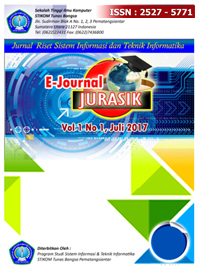Pemanfaatan Sumber Daya Kesehatan Terbatas Sebagai Pendukung Perawatan Kesehatan Cerdas
Abstract
Full Text:
PDFReferences
H. Demirkan, “A smart healthcare systems framework,” IT Prof., vol. 15, no. 5, pp. 38–45, 2013.
L. Catarinucci et al., “An IoT-Aware Architecture for Smart Healthcare Systems,” IEEE Internet Things J., vol. 2, no. 6, pp. 515–526, 2015.
P. Szolovits, J. Doyle, W. J. Long, I. Kohane, and S. G. Pauker, “Guardian Angel : Patient-Centered Health Information Systems,” no. May, pp. 1–43, 1994.
S. Sitepu, H. Mawengkang, and Irvan, “Modeling an integrated hospital management planning problem using integer optimization approach,” in Journal of Physics: Conference Series, 2017.
O. A. Fatunde and Timothy W Kotin, “Refinement of the Facility-Level Medical Technology Score to Reflect Key Disease Response Capacity and Personnel Availability,” vol. 1, no. July, 2013.
X. Chen, L. Wang, J. Ding, and N. Thomas, “Patient Flow Scheduling and Capacity Planning in a Smart Hospital Environment,” IEEE Access, vol. 4, pp. 135–148, 2016.
M. Y. Lin, K. S. Chin, and K. L. Tsui, “A weighted multi-objective therapist assignment problem in Hong Kong,” in IEEE International Conference on Industrial Engineering and Engineering Management, 2016.
L. Gu, D. Zeng, S. Guo, A. Barnawi, and Y. Xiang, “Cost efficient resource management in fog computing supported medical cyber-physical system,” IEEE Trans. Emerg. Top. Comput., 2017.
F. Ghassami and M. Ghandehary, “An investigation on the effect of electronic management information system on inventory control of hospital pharmaceutical,” in 8th International Conference on e-Commerce in Developing Countries: With Focus on e-Trust, ECDC 2014, 2014.
S. Sitepu and H. Mawengkang, “A Two-Stage Stochastic Optimization Model Of Hospital Nursing Staff Management Problem,” Int. J. Adv. Res. Comput. Eng. Technol., vol. 4, no. 1, pp. 44–47, 2015.
S. Sitepu, H. Mawengkang, and I. Husein, “Optimization Model for Capacity Management and Bed Scheduling for Hospital,” in IOP Conference Series: Materials Science and Engineering, 2018.
S. S. Savanth and K. N. R. M. Babu, “Hospital queuing-recommendation system based on patient treatment time,” in Proceedings of the 2017 International Conference on Intelligent Computing and Control Systems, ICICCS 2017, 2018.
J. Chen, K. Li, Z. Tang, K. Bilal, and K. Li, “A parallel patient treatment time prediction algorithm and its applications in hospital queuing-recommendation in a big data environment,” IEEE Access, 2016.
DOI: http://dx.doi.org/10.30645/senaris.v1i0.128
Refbacks
- There are currently no refbacks.
 








